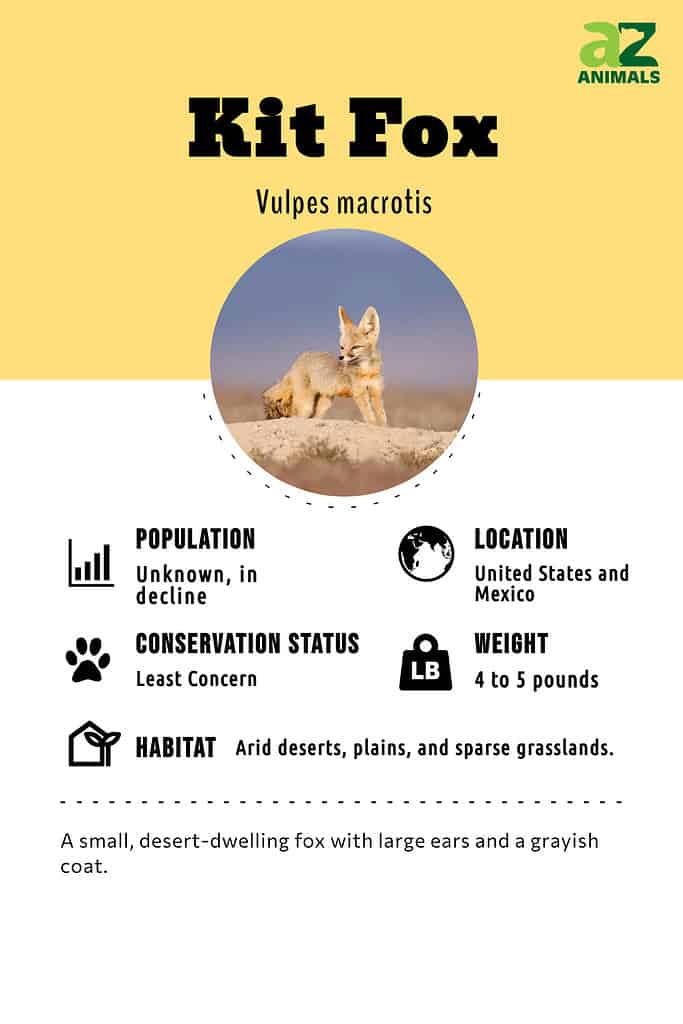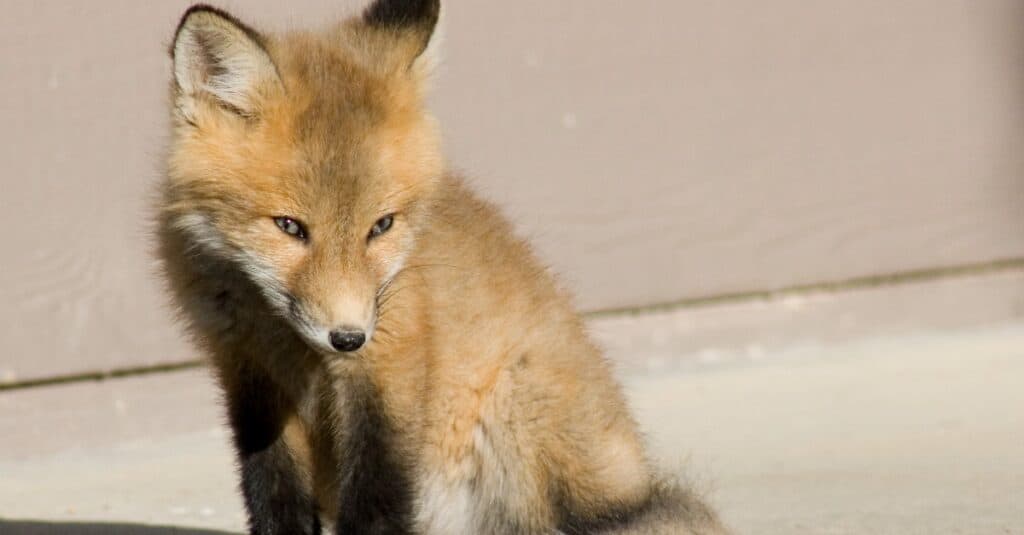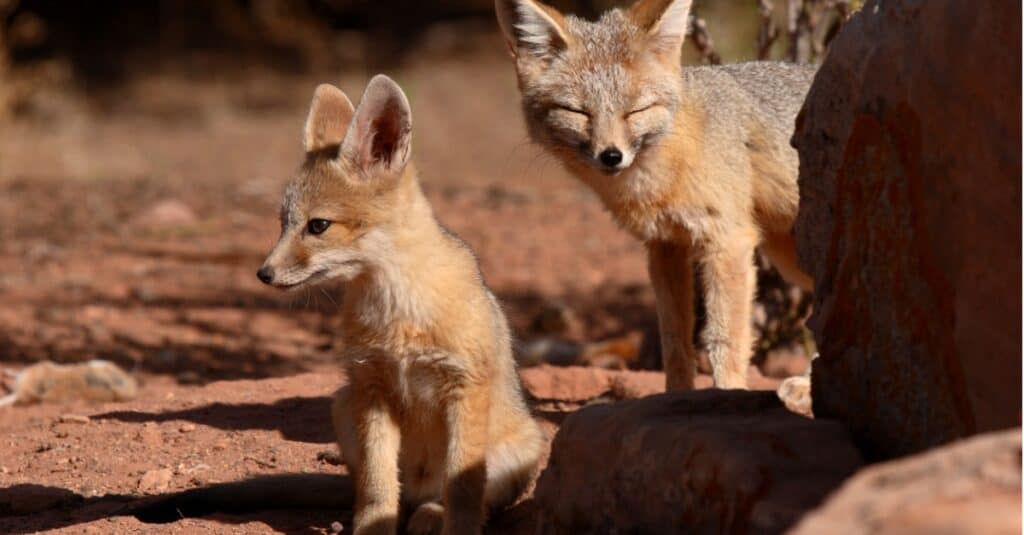Kit Fox
Vulpes macrotis merriam
The kit fox is the smallest canid in North America.
Advertisement
Kit Fox Scientific Classification
- Kingdom
- Animalia
- Phylum
- Chordata
- Class
- Mammalia
- Order
- Carnivora
- Family
- Canidae
- Genus
- Vulpes
- Scientific Name
- Vulpes macrotis merriam
Read our Complete Guide to Classification of Animals.
Kit Fox Conservation Status
Kit Fox Facts
- Prey
- kangaroo rat, cottontail, jackrabbit, reptiles, insects, birds
- Name Of Young
- pup
- Group Behavior
- Solitary
- Fun Fact
- The kit fox is the smallest canid in North America.
- Biggest Threat
- habitat destruction, competition from coyotes
- Most Distinctive Feature
- tiny bodies and enormous ears
- Gestation Period
- 49 - 55 days
- Litter Size
- one to seven pups
- Habitat
- desert, grasslands
- Predators
- coyotes, bobcats, red foxes, birds of prey
- Diet
- Omnivore
- Type
- mammal
- Common Name
- kit fox
- Number Of Species
- 1
- Location
- Southwest United States, North and Central Mexico
- Group
- solitary
Kit Fox Physical Characteristics
- Color
- Grey
- Yellow
- Black
- White
- Skin Type
- Fur
- Top Speed
- 25 mph
- Lifespan
- seven years in the wild. 12 years in captivity
- Weight
- 4.5 to five pounds
- Height
- nine to 12 inches
- Length
- 20 inches (body), 12 inches (tail)
- Age of Sexual Maturity
- 10 months
- Age of Weaning
- eight weeks
View all of the Kit Fox images!
“The kit fox is the smallest fox in North America.”
Though the dainty kit fox may look adorable, these tiny predators are actually surprisingly hardy. They’re built to expertly thrive in the desert climates they inhabit. Their enormous ears lend them both an exceptional sense of hearing and help disperse the desert heat from their bodies. Like many creatures that inhabit the deserts of the U.S. and Mexico, they’ve adapted to the desert’s daily and seasonal heat fluctuations. They use a network of underground burrows to conserve its energy during the hottest parts of the day.
Though they may be one of the smallest predators in North America’s deserts, they’ve managed to carve out an efficient niche within their habitats. While there have been some concerns about population decline, the overall population seems to be stable and well-integrated into their existing habitats.

4 Incredible Kit Fox Facts!
- While the families often have overlapping habitats, the hunting schedules of different families rarely overlap.
- There’s some debate about whether it is a distinct species. Some believe it deserves identification as a variation of the American swift fox.
- Young pups can travel up to 20 miles before settling down into their own territory away from their parents.
- The growls they use for dealing with predators versus dealing with members of the same species are distinct.
Scientific Name

The kit fox’s scientific name is
Vulpes macrotis.
©Swaroop Pixs/Shutterstock.com
The scientific name for the kit fox — Vulpes macrotis — directly translates to “big-eared fox,” and it’s a pretty accurate name. The kit fox is one of only 12 species of true foxes, all of which belong to the genus Vulpes. Among other small species like the swift fox and Bengal fox, the kit fox is the smallest. Its ears are large, even by the standards of other true foxes. These ears assist with thermoregulation during the extreme climate events in their desert habitats.
Evolution and Origins
The kit fox (Vulpes macrotis) belongs to the canid family, which includes wolves and domestic dogs. As one of the smallest members of this family, they have a fascinating evolutionary history spanning millions of years.
Fossil evidence suggests that the first true foxes appeared in North America around 7 million years ago, during the late Miocene epoch. These primitive ancestors were small and omnivorous, with sharp teeth suited for cracking open nuts and small vertebrates like lizards.
Over time, these early foxes evolved into larger and more specialized forms adapted to specific ecological niches. The emergence of grasslands during the Pliocene epoch provided new opportunities for grazing herbivores, like pronghorns and bison, as well as their predators, such as coyotes and wolves.
In response to these changes, smaller-bodied carnivores like kit foxes emerged with adaptations suited for life on arid plains. Such adaptations include their elongated ears, which help them dissipate heat while hunting at night. Populations in Mexico even live underground in dens they dig themselves!
The exact timeline of when the kit fox became its own distinct subspecies is not entirely clear. Researchers believe, though, that they diverged from other canids about 2-3 million years ago. This came after they adapted to desert environments across the southwestern United States, extending down through Mexico’s Baja California Peninsula, where most extant populations reside today.
Appearance

The ears of a kit fox aid in keeping its body cooler in the desert heat.
©iStock.com/jmhite
Fundamentally, this animal looks similar to several other fox species. Its especially small frame and large ears, though, make identification significantly easier. The latter facilitates both hearing and heat regulation, while their petite frames make them especially nimble and agile hunters. These foxes are capable of expertly stalking prey in the desert and brush valleys they inhabit.
Kit foxes’ coat colors can vary from gray to yellow, with white and black also included. That distinguishes them from many other fox species and allows them to naturally camouflage itself within its habitat range.
Desert kit foxes have also developed hair on their soles that allow them to function like snowshoes. Those hairs disperse the force of their body weight to prevent sinking into the sand. Despite being a capable survivor in their specific habitats, most specimens are smaller than the average house cat. Males tend to be slightly larger than females. That difference isn’t distinctive enough for a casual observer to tell the difference, though.
Behavior

Kit foxes are perfectly at home in the rocky desert.
©iStock.com/gatito33
The kit fox’s environment largely ordains its behavior. Everything from the colors of its coat to the shape of its head have adapted to better accommodate the heat. Further, they distinguish themselves from many other fox species by being primarily nocturnal. They do most of their hunting and foraging after dark.
The desert kit fox is solitary apart from cycles of mating and the process of raising pups.
Thanks to the harsh conditions of the desert and the dangerous variety of predators there, a kit fox’s burrows determine its daily habits. Underground dens offer these animals protection from the desert heat and overnight cold, but they also keep them safe from larger animals that see them as a meal. Kit foxes meticuolously build these dens. They usually have an entrance resembling a keyhole, which are large enough to let the fox in while keeping larger predators at bay. They also contain multiple escape routes.
Though a kit fox’s range is rarely farther than two miles from its current den, they’ll use multiple burrows over the course of a year. The kit fox may build these other burrows themselves, or repurpose and use those that other animals, like prairie dogs, built. Thanks to this quasi-nomadic nature, territories of kit foxes often overlap with little territorial friction involved. Their small appetites ensure that predators and human incursion are usually a bigger threat than competition for meals.
Habitat

Kit foxes are native to North America.
©iStock.com/gatito33
While they can reach habitats as north as Oregon, most kit foxes in the U.S. live in the southwest states. California is home to a specific population, the San Joaquin kit fox. There’s disagreement, though, on whether it should be a distinct subspecies.
Kit fox populations continue east into Colorado, Utah, Nevada, Arizona, New Mexico, and the western portions of Texas. Mexican kit fox populations live in the west and extend downward into Central Mexico.
These animals care little about state boundaries, though they’re limited to arid environments like deserts and sparse grasslands. Their adaptations — along with competition from a wider range of species — ensure a short lifespan outside of their usual habitat.
Diet
Kit foxes are omnivores and scavengers, though their diet is almost exclusively carnivorous in practical reality. Rodents are their primary form of sustenance, with kangaroo rats, squirrels, and hares being the most popular dietary choices. They may also feed on lizards and birds depending on what’s available. Kit foxes may also eat insects in desperate times. Instances of them eating cacti and fruits are likely more a response to lean feeding opportunities than a legitimate preference.
They also feed on carrion when available. Despite living in the desert, kit foxes have developed internal adaptations that allow them to process water incredibly efficiently. The six ounces of food that they need to consume a day provides them with both the nutritional sustenance and the hydration that they need, and it’s rare for a kit fox to choose to actively drink water.
They do their hunting at night, a task greatly assisted by their phenomenal hearing and their strong sense of smell. The former is facilitated by their adorably oversized ears, and their natural camouflage allows them to blend in seamlessly with their surroundings. Nighttime provides them with an extra element of cover, but they sometimes venture out to hunt early in the morning or late in the afternoon as well.
Like other true foxes, they stalk their prey quietly and then pounce on them to effectively kill or immobilize them. While the constant threat of predators and the limited temporal window for hunting makes solitary hunting the sensible preference for kit foxes, they are known to stockpile caches of food by burying it and returning to it later.
Predators and threats
Though they may pose a formidable threat to rodents, kit foxes are more likely to be seen as a potential meal to other desert mammals than as a danger. Coyotes are the biggest predatory threat to kit foxes. Some estimates suggest that three out of four kit fox deaths can be associated with coyote attacks. Red foxes and feral dogs can also prey on the smaller kit fox. They’re also sometimes victimized by birds of prey like golden eagles.
Some of the biggest challenges faced by these animals, though, come from humans. The San Joaquin kit fox has been on and off the endangered species list. It consistently faces the threat of habitat destruction thanks to the expansion of industrial energy development into their once-rural territory. Off-road vehicles can destroy kit fox burrows and the young within. Further, new highways and buildings, which fragment kit fox habitats, cause just as much destruction. There are also conflicts where humans and kit foxes meet, as the rodents that tend to flock to human settlements provide an enticing promise for kit foxes who find their prior habitats uprooted entirely.
Reproduction and Life Cycle
Kit foxes are solitary throughout most of their lifespan, but they gather together into small family units while raising their young. They are monogamous, and both the mother and the father have a role to play in raising the young. Females begin looking for dens suitable for mating in September, and they’re usually met by their partner in October. Breeding happens in the winter. Gestation takes less than two months, and early spring sees the mother give birth to her litter. During the months in between, the father does almost all of the foraging and hunting for both of them.
Litters can include as few as one or as many as seven pups and kit foxes gather into family units while raising the young. Most pups will begin to hunt with their family by an age of four months and leave the home after seven. Some will stay behind through the year to help raise the next litter of young, while the majority set out to find their own habitats. They may travel as many as 20 miles before settling on a den and a territory to call their own.
Population
The elusive nature of kit foxes makes it hard to identify their population numbers, but current estimates suggest that the world population of kit foxes is either holding steady or shrinking. While there have been attempts to break the kit fox into different subspecies, it hasn’t gained overwhelming traction. The San Joaquin kit fox is the most notable variant of this species, and they face the additional complication of viral mange outbreaks keeping their population numbers low. The IUCN lists these animals as ‘Least concern.’
View all 77 animals that start with KKit Fox FAQs (Frequently Asked Questions)
Are kit foxes carnivores, herbivores, or omnivores?
Kit foxes are technically omnivores, but meat constitutes nearly all of their diet. Though they feed primarily on rodents and carrion, they eat fruit and other vegetation on occasion.
Are kit foxes dangerous?
Kit foxes pose a threat to rodents but stay away from humans as long as they aren’t pursued. Leave a kit fox alone, and they’ll return the favor to you.
Are kit foxes friendly?
Kit foxes may look cute, but they’re wild animals that are more likely to flee than pursue humans and won’t hesitate to bite if they find themselves cornered.
How many kit foxes are left?
Exact numbers regarding the kit fox population are unknown, although the IUCN Red List considers the species to be of least concern. Their elusive and nocturnal nature makes a population estimate difficult, but there are concerns that their population is declining.
Why are kit foxes endangered?
Though kit foxes aren’t technically endangered, there are concerns about their long-term lifespan as a species. Human encroachment into kit fox territories has devastated many of their habitats, and the San Joaquin kit fox has been considered endangered in the past.
What does a kit fox eat?
Kit foxes are omnivores who sometimes eat fruit, but the bulk of their diet is rodents. Kangaroo rats are a common choice, but kit foxes aren’t such picky eaters that they won’t pursue roadkill, snakes, or flightless birds if they have the chance.
What is a kit fox?
A kit fox is a species of fox found in Mexico and the southwest United States. Identification from other foxes is easy thanks to their small sizes, their desert-themed colors, and their enormous ears. Despite that, they’re sometimes mistaken for the similar-looking fennec fox.
Thank you for reading! Have some feedback for us? Contact the AZ Animals editorial team.
Sources
- IUCN, Available here: https://www.iucnredlist.org/species/41587/62259374
- National Park Service, Available here: https://www.nps.gov/jotr/learn/nature/kitfox.htm#:~:text=In%20addition%20to%20nocturnal%20rodents,remaining%20inactive%20in%20underground%20dens.
- Center for Biological Diversity, Available here: https://www.biologicaldiversity.org/species/mammals/desert_kit_fox/index.html
- Animal Ark, Available here: https://animalark.org/education/learn-about-animals/family-canidae/kit-fox/
- Morris Animal Foundation, Available here: https://www.morrisanimalfoundation.org/article/highly-contagious-infection-threatens-endangered-san-joaquin-kit-fox-population
- fs.usda.gov, Available here: https://www.fs.usda.gov/Internet/FSE_DOCUMENTS/stelprdb5181917.pdf
- World Atlas, Available here: https://www.worldatlas.com/articles/the-twelve-species-of-true-foxes.html

















